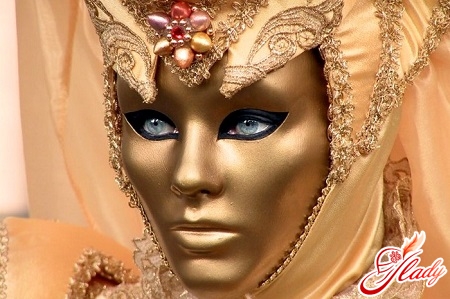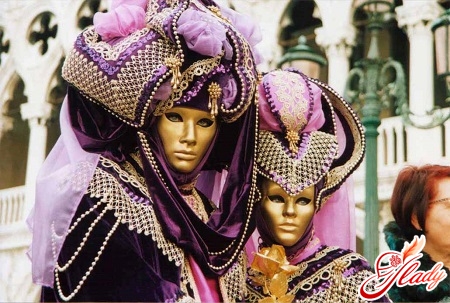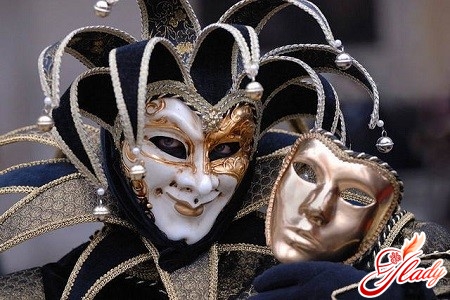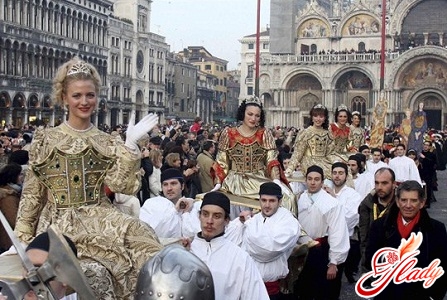 The Venice Carnival is a time of fun,crazy luxury and extravagance. Beautiful ladies dancing in the streets and gallant gentlemen losing entire fortunes under the roofs of gambling houses - all this is about it! It seems that the very soul of the ancient city on the water comes to life, filling everything around with the spirit of a magical extravaganza. Just one mention of the carnival taking place in Venice colors the thoughts with a riot of colors and sounds. The holiday erases the fine line between everyday reality and fantastic mystery, making possible the harmonious coexistence of different eras, hides racial and social differences behind masks, immerses each participant in the atmosphere of a miracle come true. Nights, permeated with the mysterious light of lanterns, candles and fireworks, become a time of reckless love affairs and light flirtation. Every year before Lent a wave of carnivals rolls around the world: France, Switzerland, Santa Cruz, Rio de Janeiro. You can travel through European cities, sometimes plunging into the fun with silly dancing and beer in Cologne, sometimes falling under a hail of orange "shells" in Ivrea, sometimes becoming a witness to the amusing funeral of a cardboard Sardine in Tenerife. But none of these holidays can compare in their delightful sophistication, scope, antiquity and popularity with the carnivals of Venice. No matter how hard the inhabitants of other countries try to reproduce something similar in their homeland, inventing interesting processions, parades and all sorts of entertainment events, the originality of Venice remains unattainable and enticing. For ten days, a fascinating spectacle unfolds on the streets, squares, canals and bridges of this unique city: the carnival of masks!
The Venice Carnival is a time of fun,crazy luxury and extravagance. Beautiful ladies dancing in the streets and gallant gentlemen losing entire fortunes under the roofs of gambling houses - all this is about it! It seems that the very soul of the ancient city on the water comes to life, filling everything around with the spirit of a magical extravaganza. Just one mention of the carnival taking place in Venice colors the thoughts with a riot of colors and sounds. The holiday erases the fine line between everyday reality and fantastic mystery, making possible the harmonious coexistence of different eras, hides racial and social differences behind masks, immerses each participant in the atmosphere of a miracle come true. Nights, permeated with the mysterious light of lanterns, candles and fireworks, become a time of reckless love affairs and light flirtation. Every year before Lent a wave of carnivals rolls around the world: France, Switzerland, Santa Cruz, Rio de Janeiro. You can travel through European cities, sometimes plunging into the fun with silly dancing and beer in Cologne, sometimes falling under a hail of orange "shells" in Ivrea, sometimes becoming a witness to the amusing funeral of a cardboard Sardine in Tenerife. But none of these holidays can compare in their delightful sophistication, scope, antiquity and popularity with the carnivals of Venice. No matter how hard the inhabitants of other countries try to reproduce something similar in their homeland, inventing interesting processions, parades and all sorts of entertainment events, the originality of Venice remains unattainable and enticing. For ten days, a fascinating spectacle unfolds on the streets, squares, canals and bridges of this unique city: the carnival of masks!
From the history of the carnival
The first mentions of such a celebration go backсвоими корнями во времена язычества. Да и само слово «карнавал», как свидетельствует история, произошло от латинского «carrus navalis» — названия повозки, на которой еще в Бронзовом веке перевозились идолы плодородия. Прототипом современного праздника принято считать древнеримские Сатурналии — торжества, посвященные богу плодородия и урожая Сатурну. В те дни римляне воскрешали «золотой век» всеобщего равенства. Стирались грани между рабами и свободными гражданами, а господа ели за одним столом с чернью. Нужно отметить, что языческие праздники редко обходились без жертвоприношений. Так, в охваченной карнавалом Венеции в древности существовал варварский обычай. Его суть сводилась к тому, что на весь период торжеств избирался лжекороль, который по завершении сатурналий должен был либо совершить самоубийство, либо погибнуть на костре или от ножа. Таковы были народные «развлечения» во времена языческого поклонения богам. С началом христианства сатурналии были запрещены, но идея перевоплощения, уравнивающего между собой всех участников, пережила века и возродилась в европейских карнавалах. И нет ничего удивительного в том, что именно Италия, жители которой известны своим веселым нравом и неуемной тягой к праздникам, стала родиной столь популярных торжеств. Сейчас уже сложно сказать, какая из версий о времени проведения первого в Венеции карнавала верна: история не дает точного ответа на этот вопрос. Но самое раннее документальное упоминание датируется XI веком. Доподлинно же известно, что в XIII веке последний день перед Великим постом был объявлен в этом итальянском городе днем народных гуляний. Все его население, одетое в маски и костюмы, стекалось на площадь Сан-Марко поучаствовать во всеобщем веселье и плясках. В XVIII веке венецианский карнавал достиг своего наивысшего расцвета. Пьянящая атмосфера вседозволенности, дух флирта и измены, предвкушение незабываемых приключений притягивали аристократов со всей Европы. И даже августейшие особы и принцы крови не считали зазорным инкогнито появляться на улицах и принимать участие в разгульном веселье. На период карнавалов в Венеции сам город становился храмом масок, в них не только праздновали, но и занимались обычными делами. Жители, скрыв лица за разноцветными накладками, ходили за покупками и на службу. Маска стирала все нормы поведения и морали, даря ощущение свободы и вседозволенности. В XVIII веке герои итальянской комедии дель арте стали главными действующими лицами проходящего в Венеции карнавала — тысячи Арлекинов, Панталоне, Пьеро появились на улицах. Именно тогда праздник обрел свою эмблему. Ею стала Коломбина. Одновременно с этим значимым событием появилась традиция, дошедшая и до наших дней: запускать бумажную голубку — Коломбину — с колокольни Сан-Марко. Она взрывается над площадью, осыпая собравшихся дождем конфетти, и открывает тем самым венецианский карнавал. Как это ни печально, но даже столь популярным как среди знати, так и у простых горожан гуляниям не удалось избежать забвения. Падение Республики и революционные настроения конца XVIII века привели к тому, что веселый дух Венеции — карнавал — практически угас. В 20-е годы прошлого века Бенито Муссолини официально запретил его проведение. Но история этих потрясающих торжеств, к счастью, не завершилась столь печальным образом. И как любая сказка, имеющая счастливый конец, как птица Феникс, возрождающаяся из пепла, венецианский карнавал обрел «второе дыхание». В 1979 году, благодаря Федерико Феллини и с разрешения Папы Римского, бумажная голубка снова взвилась над площадью Сан-Марко, и праздник вновь хлынул на улицы древнего города, пробуждая в людях надежду и даруя радость. А в 1996 году известный кутюрье Пьер Карден написал для проходящего тогда в Венеции карнавала гимн. Особенностью праздника стал ежегодный выбор новой тематики, сохранение традиций прошлого и гармоничное их соединение с духом современности. 
The march is a tribute to beauty and courage
The Carnival of Venice officially opensthe descent of the "angel" from the hundred-meter bell tower in the Piazza San Marco. The holiday falls on the city like a multi-colored snow of confetti. The hubbub, laughter, and music, sounding everywhere, form a cacophony of cheerful sounds. A multi-lingual crowd in a single impulse marches through the Piazza San Marco, recreating the story of the kidnapping of twelve girls by pirates from Istria and their rescue by brave townspeople. This is the notorious parade of Mary - a tradition that has come down to us from the depths of centuries and has become an integral part of the carnival held in Venice. The background to this event, according to the townspeople, is based on real events. In the distant year of 943, a special date was provided for weddings in Venice. It was on February 2, the day of the Presentation of Mary, that wedding processions with twelve brides sailed along the canal of the "virgins", heading to the Church of St. Nicholas. It was there that the girls were supposed to meet their suitors. But such a joyful event was marred by an attack by pirates who kidnapped the brides along with their dowry. The angry Venetians began to pursue the sea robbers and in a fight with them freed their beautiful compatriots. According to some sources, since then, by decision of the government, every year twelve of the poorest girls in Venice named Maria were married off at the expense of local rich people. Wealthy families allocated money for the purchase of a dowry and the organization of the celebration. Although, according to other information, dowryless Marias married the sons of the local bourgeoisie on this day. Still other sources claim that in order to perpetuate the feat of the brave Venetians, a kind of beauty contest was simply organized with the participation of twelve girls, two from each district of the city. True, it was more of a religious nature, since the beauties had to be present at all the city's religious services. The girls were called Maria, dressed in luxurious clothes and did not spare jewelry. All three legends agree on one thing: the expenses for organizing mass celebrations fell heavily on the shoulders of the rich nobility. Therefore, gradually the number of beauties was reduced to three, and then the living girls were replaced with wooden dolls, which caused protests among the people. Now this tradition, overgrown with legends and tales, has turned into a kind of theatrical procession, without which the annual carnival held in Venice is not complete. On the first Saturday of the holidays, twelve young Venetian girls, accompanied by extras in historical costumes and musicians, gather at the Church of St. Peter (San Pietro di Castello) and go to St. Mark's Square. It is here that the most beautiful Venetian girl is determined the next day. The girl who has been so honorably chosen receives a valuable prize.
Features of the carnival these days
The 2011 Venice Carnival wasdedicated to the beautiful half of humanity, as its end coincided with the Eighth of March — International Women's Day. The imagination of the organizers truly knew no bounds and turned the holiday into a romantic ode to the fair sex. Those who were lucky enough to be in Venice at that time, enthusiastically share their impressions. The outfits deserve special attention. The costumes had to match the heroines of the post-romantic era, led by Elizabeth of Bavaria, and the traditional clothes of the Middle Ages were replaced by crinolines, corsets, fans and frock coats. The carnival in 2012 was held under the motto "Life is a theater, put on your masks!" Agree, this is very symbolic. For ten days dedicated to traditional celebrations, the ancient city on the water personified the capital of European theatrical art. The opening of the festival began with the procession of the Marys, the mayor's speech and a beautiful performance, when a girl in the guise of an Angel descended from the bell tower. Since the theme of the carnival organized in Venice was theater, the numerous guests of the festival had many opportunities to see colorful productions and shows with their own eyes. These were traditional commedia dell'arte, and a festival of Balkan music, and a parade of carnival costumes and many other interesting and bright events. The party on February 16 deserves special attention. On this day, closer to midday, several original performances took place in a continuous series on St. Mark's Square. And at night, according to the organizers and participants of the carnival held in Venice, the city was immersed in the atmosphere of the old traditions of the festival. It can be said that for ten whole days the ancient Italian city suddenly turned into a huge theater stage for a large-scale production of a director-magician. There were roles for both participants and spectators, so the success exceeded all expectations. As for 2013, the traditional carnival in Venice was held under the motto "Live in color" and its main themes were two water elements - water and fire. Perhaps it was not for nothing that the city was covered with rain on the opening day? Perhaps nature itself blessed the holiday in such a "wet" way. In addition, the theme of flowers chosen for the carnival is also appropriate for the reason that Venice has become the "cradle" of painting. Canaletto and Guardi, Bellotto and Titian, Giorgione and Veronese worked on their immortal masterpieces here. Each day of the celebrations was dedicated to a new color. Spectators could see three flights from the bell tower on St. Mark's Square at once: the traditional descent of the Angel, as well as the descent of the Eagle and the Lion. All other events, including circus performances, a regatta along the canals of Venice, painting exhibitions, mask competitions, costume processions and concerts, were somehow connected with the main theme.
Do not be afraid to try on the mask!
Lately there has been a strong spirit of unity and freedomhas ceased to hover over the carnival in the ancient city: people have divided into participants and spectators. The atmosphere of mystery has disappeared, the enigma has faded, and even the general unrestrained joy does not bring the same satisfaction. The modern Venetian carnival is gradually losing its original meaning and is turning into a purely tourist event. The feeling of nationality and community is lost, because the division into spectators and performers destroys the long-standing harmony of the holiday. And so its essence becomes theatrical processions, where, unfortunately, there are fewer and fewer masks, and more and more camera flashes and ordinary curious inhabitants. Indeed, the average European tourists who come to the carnival prefer to remain on the sidelines and choose for themselves the position of an observer of the grotesque action. It is so easy to succumb to the mood of the cheerful Venetians, buy a mask of incredible design and brightness, try on an unusual costume and join the passing procession! It is direct participation that will help you feel the real free spirit of the holiday, feel how time frames part in an instant, and the breath of ancient events touches your cheek for a moment. After all, it is not all about a cheerful mood and the expectation of miracles and spectacles. It is important to catch a special worldview, freedom, community with masks, utopianism and experience unity with the eternal and beautiful, suddenly realizing that the past, present and future are inseparable. Therefore, do not be afraid to try on a mask! True, the choice of this carnival symbol and the corresponding costume will entail considerable costs, because traditional outfits are of very good quality. They are sewn from brocade or velvet and are often decorated with natural fur. But can you compare the money spent with the indescribable brightness and strength of emotions that fall upon a person as soon as he becomes “one of them” among the masks? The world changes if you look at it through mysterious slits for the eyes, hiding your true essence behind a grotesque mask. By the way, participation in the annual Venice carnival requires strict adherence to the rules. Without them, the costumed action loses its mystery. Therefore, having dressed up, do not talk, but communicate with others using gestures. Acquaintance consists of handing over business cards. And do not forget to have a snack, because in a mask you are unlikely to be able to treat yourself to a glass of wine or traditional donuts. But any holiday, even the most beautiful, comes to an end. The bright fireworks have died down, the participants reluctantly remove the grotesque masks from their tired faces, gradually merging with the crowd of spectators... And now the straw effigy is ablaze with tongues of flame, illuminating St. Mark's Square, and the ghostly-fragile Venice, like an eternally young dancer frozen in an unthinkable step, is reflected in the mirror frame of the waters in anticipation of a new carnival...









